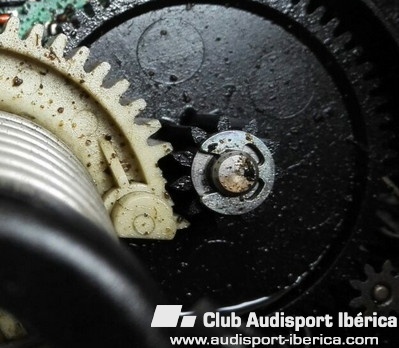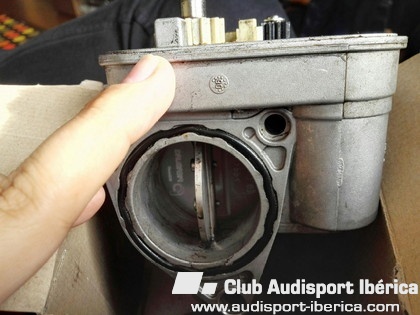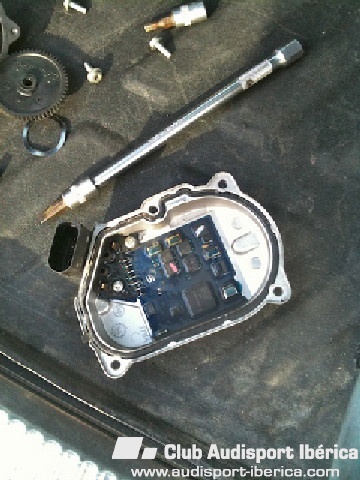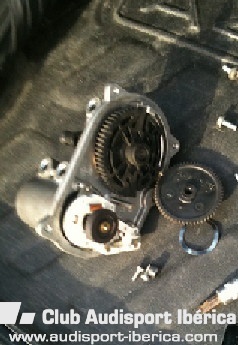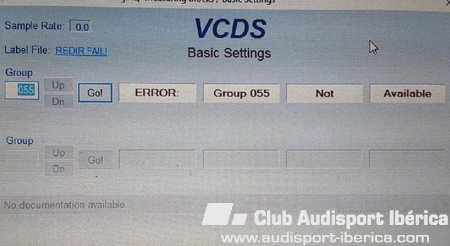-
Mensajes
196 -
Ingresó
-
Última visita
Tipo de contenido
Perfiles
Foros
Calendario
Tienda
Todo lo publicado por jose_bkw
-

BRICO RESTAURACIÓN CLIMA OEM - METODO ALTERNATIVO
jose_bkw responde a raulindj de discusión en Audi A4 B6/B7 (2002-2008)
Simplemente genial, eres un crack, Enhorabuena -

Filtro de Partículas Diesel - Regeneraciones - 2ª parte
jose_bkw responde a Sardinero de discusión en Mecánica General Audi
?????? muy bueno. Gracias -

Como desmontar el Turbo en un A3 tdi 130 cv.
jose_bkw responde a JULIOA3 de discusión en Audi A3 8L (1996-2003)
Si eres de Salamanca te puedo echar una mano, nunca he desmontado el turbo de ese modelo pero así práctico con tu coche, jeje, es broma. Ya hablamos. -

Problema Colector admision A4 Avant 3.0 TDI HELP
jose_bkw responde a DaniAvanti de discusión en Mecánica General Audi
Creo que no -

Problema Colector admision A4 Avant 3.0 TDI HELP
jose_bkw responde a DaniAvanti de discusión en Mecánica General Audi
Vamos a ver, siempre que montas y desmontas hay q hacer un ajuste básico. Es tan fácil como entrar en 01 engine, dentro de engine basic setting y seleccionar canal 44 y pisar acelerador a fondo, el motor no acelerara más de 1500 vueltas creo, tarda 2 o 3 minutos. Luego canal 55 y lo mismo. Para turbo igual y para egr igual. Que lo montas y no lo haces pues bien pero dudo que quede memorizado correctamente el final de carrera del inicio y fin. Que funcione, no lo dudo, bien, no lo creo. -

Problema Colector admision A4 Avant 3.0 TDI HELP
jose_bkw responde a DaniAvanti de discusión en Mecánica General Audi
Entra en engine en basic setting y como te decía canales 44 y 55 es para chapelas de admisión. Te dejo aquí todos los ajustes que puedes hacer. 003 Basic setting: Exhaust gas recirculation 1) Coolant temperature at least 80 °C 2) Switch off ignition briefly, then start engine 3) Start basic setting 4) Follow driver instructions (pedals must be pressed) 5) Wait for the engine speed rise to approx. 1000 rpm KNote: The exhaust gas recirculation is now switched on and off intermittently. Specifications with "EGR not active": Engine speed: approx. 1000 rpm Activation: EGR not active Actual air mass: 380 ... 550 mg/stroke EGR valve feedback: 0 ... 2 % Specifications with "EGR active": Engine speed: approx. 1000 rpm Activation: EGR active Actual air mass: 140 ... 270 mg/stroke EGR valve feedback: 80 ... 100 % 033 Basic setting: Turbocharger 1) Coolant temperature at least 80 °C 2) Switch off ignition briefly, then start engine 3) Start basic setting 4) Follow driver instructions (pedals must be pressed) 5) Wait for the engine speed rise to approx. 1000 rpm KNote: The turbocharger is now activated at intervals at different duty cycles. Specifications at "closed": Engine speed: approx. 1000 rpm Activation: closed Actual charge pressure: 970 ... 1150 mbar Charge pressure adjuster feedback: 98 ... 100 % Specifications at "open": Engine speed: approx. 1000 rpm Activation: open Actual charge pressure: 910 ... 1050 mbar Charge pressure adjuster feedback: 0 ... 2 % Charge pressure difference between "closed/open": 50 ... 135 mbar OK is OK 044 Basic setting: Intake manifold flap bank 1 1) Coolant temperature at least 80 °C 2) Switch off ignition briefly, then start engine 3) Start basic setting 4) Follow driver instructions (pedals must be pressed) 5) Wait for the engine speed rise to approx. 2800 rpm KNote: The bank 1 intake manifold flaps are now alternately opened and closed at intervals. Specifications with "flap open": Engine speed: approx. 2800 rpm Activation: Flap open Actual air mass: [mg/stroke] Intake manifold flap bank 1 feedback: 3 ... 7 % Specifications with "flap closed": Engine speed: approx. 2800 rpm Activation: Flap closed Actual air mass: [mg/stroke] Intake manifold flap bank 1 feedback: 93 ... 97 % Air mass difference between "flap open/closed": min. 20 mg/stroke 055 Basic setting: Intake manifold flap bank 2 1) Coolant temperature at least 80 °C 2) Switch off ignition briefly, then start engine 3) Start basic setting 4) Follow driver instructions (pedals must be pressed) 5) Wait for the engine speed rise to approx. 2800 rpm KNote: The bank 2 intake manifold flaps are now alternately opened and closed at intervals. Specifications with "flap open": Engine speed: approx. 2800 rpm Activation: Flap open Actual air mass: [mg/stroke] Intake manifold flap bank 2 feedback: 3 ... 7 % Specifications with "flap closed": Engine speed: approx. 2800 rpm Activation: Flap closed Actual air mass: [mg/stroke] Intake manifold flap bank 2 feedback: 93 ... 97 % Air mass difference between "flap open/closed": min. 20 mg/stroke 063 Adapting kickdown point Not AUDI A8 Only vehicles with automatic gearbox 1) Switch off ignition briefly, then ignition on 2) Start basic setting 3) Press down accelerator pedal until status ADP OK is displayed 4) Value is only stored in engine control unit after approx. 10 seconds ignition OFF. Specifications: Sender 1 Accelerator position: 12 ... 97 % --- Status: ADP.OK 159 Basic setting: Oil pressure valve 1) Engine oil temperature at least 60 °C 2) Switch off ignition briefly, then start engine 3) Start basic setting 4) Follow driver instructions (pedals must be pressed) KNote: First the low pressure stage is run for 8 seconds. During this time the engine speed is increased to 2300 rpm. Then the system switches to the high pressure stage, which is likewise active for 8 seconds. Specifications in the low pressure stage: Oil pressure switching valve: 1(low pressure requested) Low-pressure switch: 1(closed) High-pressure switch: 0(open) Specifications in the high pressure stage: Oil pressure switching valve: 0(high pressure requested) Low-pressure switch: 1(closed) High-pressure switch: 1(closed) -

Problema Colector admision A4 Avant 3.0 TDI HELP
jose_bkw responde a DaniAvanti de discusión en Mecánica General Audi
Si hay q hacer ajuste básico, creo q eran los canales 44 y 55 de engine. -

Problema Colector admision A4 Avant 3.0 TDI HELP
jose_bkw responde a DaniAvanti de discusión en Mecánica General Audi
No se como los tendrás de desgastados, yo los limpie únicamente y como Dios. -
Upss creo que no leí bien, y necesitabas otro tipo de ayuda, sorry.
-
Vamos a ver, es el huevo de Colón. Comprar dos botes de dot4. Extraer el microfiltro del depósito (sale mal o muy mal), con una jeringuilla sacáis todo el líquido y con papel limpiar bien el depósito por dentro. Llegar hasta arriba y empezar por la rueda trasera derecha (mirar desde sentado en posición de conductor). Tiene un tapon y una especie de tuerca con un pispajo en el centro. En pispajo de centro colocar un tubo de esos transparentes que venden en cualquier ferretería directo a una botella de plástico. Ahora viene la cuestión, s Una persona en puesto de conductor bombea 5,6 o 7 veces freno y cuando está con presión arriba abre tuerca el de la rueda, y siempre siempre apretar tuerca antes de que el que este pisando freno levanté pie. O al contrario no levantar pie de freno que se hundió hasta no haber apretado tuerca. Ese proceso se repite 14 veces trasera derecha, seguido de trasera izquierda, delantera derecha y delantera izquierda. Luego probar freno con frenadas fuertes, las dos o tres primeras frenadas le cuesta abs luego ya purgado y la diferencia notable.
-

Pedal de freno blando y frena muy poco Ayuda!!
jose_bkw responde a siloeb de discusión en Mecánica Audi A4 B8
Prueba una purga de frenos, por Dos duros lo has hecho y descartas posibilidades -

averia en valvula agr con 51045 km y 4 años y 4 meses
jose_bkw responde a antonio_jose de discusión en Mecánica General Audi
Si tienes razón susopampin, lo único q le tendrá q sacar la cremallera y que le haga un scanner, una pequeña modificación de dientes rotos y a correr -

averia en valvula agr con 51045 km y 4 años y 4 meses
jose_bkw responde a antonio_jose de discusión en Mecánica General Audi
Mira esta es como tú egr y el fallo que dan Si eres un poco hábil y no quieres gastar euros le puedes hacer un añadido con unas pequeñas pletinas de aluminio clavadas y luego rellenar con epoxi para hacerle la forma y rematar con dremel. -
A mi me sale AUDI : 059 906 088AE pero para asegurarte mira en alguna web sobre recambios dándole el número de bastidor. Yo lo hice así y sin problema. En mi caso el mismo modelo en automático o manual variaba la terminación, uno era en a y otro en h.
-

Que me podeis decir de estos datos vag com
jose_bkw responde a bemmequer de discusión en Vag-Com Audi A4 B6/B7
Okis gracias carlisu -

Que me podeis decir de estos datos vag com
jose_bkw responde a bemmequer de discusión en Vag-Com Audi A4 B6/B7
Si si, eso lo vi. El mío es un 12.12 y no sale nada de eso. Bueno será así, es chino. A lo que me refería del modelo es por si existiera alguna otra vertiente de software o algo. -

Que me podeis decir de estos datos vag com
jose_bkw responde a bemmequer de discusión en Vag-Com Audi A4 B6/B7
bemmequer donde compraste vag o que modelo es? A mi no me salen los datos de los rangos que se encuentran abajo de cada casilla. -

Intake Manifold Runner Control tras cambiar mariposas
jose_bkw responde a ekrano de discusión en Audi A6 / Allroad C6 (2005 - 2011)
Esto es uno general, con hacer el 44 y el 55 te vale que son las chapelas para que sepan los servomotores cual es el recorrido que tienen y no se vaya de recorrido. 003 Basic setting: Exhaust gas recirculation 1) Coolant temperature at least 80 °C 2) Switch off ignition briefly, then start engine 3) Start basic setting 4) Follow driver instructions (pedals must be pressed) 5) Wait for the engine speed rise to approx. 1000 rpm KNote: The exhaust gas recirculation is now switched on and off intermittently. Specifications with "EGR not active": Engine speed: approx. 1000 rpm Activation: EGR not active Actual air mass: 380 ... 550 mg/stroke EGR valve feedback: 0 ... 2 % Specifications with "EGR active": Engine speed: approx. 1000 rpm Activation: EGR active Actual air mass: 140 ... 270 mg/stroke EGR valve feedback: 80 ... 100 % 033 Basic setting: Turbocharger 1) Coolant temperature at least 80 °C 2) Switch off ignition briefly, then start engine 3) Start basic setting 4) Follow driver instructions (pedals must be pressed) 5) Wait for the engine speed rise to approx. 1000 rpm KNote: The turbocharger is now activated at intervals at different duty cycles. Specifications at "closed": Engine speed: approx. 1000 rpm Activation: closed Actual charge pressure: 970 ... 1150 mbar Charge pressure adjuster feedback: 98 ... 100 % Specifications at "open": Engine speed: approx. 1000 rpm Activation: open Actual charge pressure: 910 ... 1050 mbar Charge pressure adjuster feedback: 0 ... 2 % Charge pressure difference between "closed/open": 50 ... 135 mbar OK is OK 044 Basic setting: Intake manifold flap bank 1 1) Coolant temperature at least 80 °C 2) Switch off ignition briefly, then start engine 3) Start basic setting 4) Follow driver instructions (pedals must be pressed) 5) Wait for the engine speed rise to approx. 2800 rpm KNote: The bank 1 intake manifold flaps are now alternately opened and closed at intervals. Specifications with "flap open": Engine speed: approx. 2800 rpm Activation: Flap open Actual air mass: [mg/stroke] Intake manifold flap bank 1 feedback: 3 ... 7 % Specifications with "flap closed": Engine speed: approx. 2800 rpm Activation: Flap closed Actual air mass: [mg/stroke] Intake manifold flap bank 1 feedback: 93 ... 97 % Air mass difference between "flap open/closed": min. 20 mg/stroke 055 Basic setting: Intake manifold flap bank 2 1) Coolant temperature at least 80 °C 2) Switch off ignition briefly, then start engine 3) Start basic setting 4) Follow driver instructions (pedals must be pressed) 5) Wait for the engine speed rise to approx. 2800 rpm KNote: The bank 2 intake manifold flaps are now alternately opened and closed at intervals. Specifications with "flap open": Engine speed: approx. 2800 rpm Activation: Flap open Actual air mass: [mg/stroke] Intake manifold flap bank 2 feedback: 3 ... 7 % Specifications with "flap closed": Engine speed: approx. 2800 rpm Activation: Flap closed Actual air mass: [mg/stroke] Intake manifold flap bank 2 feedback: 93 ... 97 % Air mass difference between "flap open/closed": min. 20 mg/stroke 063 Adapting kickdown point Not AUDI A8 Only vehicles with automatic gearbox 1) Switch off ignition briefly, then ignition on 2) Start basic setting 3) Press down accelerator pedal until status ADP OK is displayed 4) Value is only stored in engine control unit after approx. 10 seconds ignition OFF. Specifications: Sender 1 Accelerator position: 12 ... 97 % --- Status: ADP.OK 159 Basic setting: Oil pressure valve 1) Engine oil temperature at least 60 °C 2) Switch off ignition briefly, then start engine 3) Start basic setting 4) Follow driver instructions (pedals must be pressed) KNote: First the low pressure stage is run for 8 seconds. During this time the engine speed is increased to 2300 rpm. Then the system switches to the high pressure stage, which is likewise active for 8 seconds. Specifications in the low pressure stage: Oil pressure switching valve: 1(low pressure requested) Low-pressure switch: 1(closed) High-pressure switch: 0(open) Specifications in the high pressure stage: Oil pressure switching valve: 0(high pressure requested) Low-pressure switch: 1(closed) High-pressure switch: 1(closed) -
Te dejo aquí los ajustes del 3.0tdi, es todo comandado con servomotores a excepción de una válvula de refrigeración de egr, turbo, chapelas de Banco derecho e izquierdo, egr. Dentro de basic setting tienes esto 003 Basic setting: Exhaust gas recirculation 1) Coolant temperature at least 80 °C 2) Switch off ignition briefly, then start engine 3) Start basic setting 4) Follow driver instructions (pedals must be pressed) 5) Wait for the engine speed rise to approx. 1000 rpm KNote: The exhaust gas recirculation is now switched on and off intermittently. Specifications with "EGR not active": Engine speed: approx. 1000 rpm Activation: EGR not active Actual air mass: 380 ... 550 mg/stroke EGR valve feedback: 0 ... 2 % Specifications with "EGR active": Engine speed: approx. 1000 rpm Activation: EGR active Actual air mass: 140 ... 270 mg/stroke EGR valve feedback: 80 ... 100 % 033 Basic setting: Turbocharger 1) Coolant temperature at least 80 °C 2) Switch off ignition briefly, then start engine 3) Start basic setting 4) Follow driver instructions (pedals must be pressed) 5) Wait for the engine speed rise to approx. 1000 rpm KNote: The turbocharger is now activated at intervals at different duty cycles. Specifications at "closed": Engine speed: approx. 1000 rpm Activation: closed Actual charge pressure: 970 ... 1150 mbar Charge pressure adjuster feedback: 98 ... 100 % Specifications at "open": Engine speed: approx. 1000 rpm Activation: open Actual charge pressure: 910 ... 1050 mbar Charge pressure adjuster feedback: 0 ... 2 % Charge pressure difference between "closed/open": 50 ... 135 mbar OK is OK 044 Basic setting: Intake manifold flap bank 1 1) Coolant temperature at least 80 °C 2) Switch off ignition briefly, then start engine 3) Start basic setting 4) Follow driver instructions (pedals must be pressed) 5) Wait for the engine speed rise to approx. 2800 rpm KNote: The bank 1 intake manifold flaps are now alternately opened and closed at intervals. Specifications with "flap open": Engine speed: approx. 2800 rpm Activation: Flap open Actual air mass: [mg/stroke] Intake manifold flap bank 1 feedback: 3 ... 7 % Specifications with "flap closed": Engine speed: approx. 2800 rpm Activation: Flap closed Actual air mass: [mg/stroke] Intake manifold flap bank 1 feedback: 93 ... 97 % Air mass difference between "flap open/closed": min. 20 mg/stroke 055 Basic setting: Intake manifold flap bank 2 1) Coolant temperature at least 80 °C 2) Switch off ignition briefly, then start engine 3) Start basic setting 4) Follow driver instructions (pedals must be pressed) 5) Wait for the engine speed rise to approx. 2800 rpm KNote: The bank 2 intake manifold flaps are now alternately opened and closed at intervals. Specifications with "flap open": Engine speed: approx. 2800 rpm Activation: Flap open Actual air mass: [mg/stroke] Intake manifold flap bank 2 feedback: 3 ... 7 % Specifications with "flap closed": Engine speed: approx. 2800 rpm Activation: Flap closed Actual air mass: [mg/stroke] Intake manifold flap bank 2 feedback: 93 ... 97 % Air mass difference between "flap open/closed": min. 20 mg/stroke 063 Adapting kickdown point Not AUDI A8 Only vehicles with automatic gearbox 1) Switch off ignition briefly, then ignition on 2) Start basic setting 3) Press down accelerator pedal until status ADP OK is displayed 4) Value is only stored in engine control unit after approx. 10 seconds ignition OFF. Specifications: Sender 1 Accelerator position: 12 ... 97 % --- Status: ADP.OK 159 Basic setting: Oil pressure valve 1) Engine oil temperature at least 60 °C 2) Switch off ignition briefly, then start engine 3) Start basic setting 4) Follow driver instructions (pedals must be pressed) KNote: First the low pressure stage is run for 8 seconds. During this time the engine speed is increased to 2300 rpm. Then the system switches to the high pressure stage, which is likewise active for 8 seconds. Specifications in the low pressure stage: Oil pressure switching valve: 1(low pressure requested) Low-pressure switch: 1(closed) High-pressure switch: 0(open) Specifications in the high pressure stage: Oil pressure switching valve: 0(high pressure requested) Low-pressure switch: 1(closed) High-pressure switch: 1(closed)
-
Carlisu es extraño, xq antes entraba sin problema alguno. Era para hacer ajuste básico de turbo xq tengo pensado cambiar tensores de distribución ya que tengo el famoso ruido de claqueteo al arrancar. Haré su correspondiente brico.
-

Intake Manifold Runner Control tras cambiar mariposas
jose_bkw responde a ekrano de discusión en Audi A6 / Allroad C6 (2005 - 2011)
La placa donde tiene el potenciometro y los contactos los has limpiado? Y ajuste básico, lo hiciste después? -

Otra vez problemas en el colector del banco 2
jose_bkw responde a albercall de discusión en Audi A6 / Allroad C6 (2005 - 2011)
-

Otra vez problemas en el colector del banco 2
jose_bkw responde a albercall de discusión en Audi A6 / Allroad C6 (2005 - 2011)
Antes de comprar servo nuevo prueba a desmontar y limpiarlo, ya q lo vas a comprar de todas formas lo mismo te lo ahorras -

Group 20 engine, valor extraño.
jose_bkw responde a jose_bkw de discusión en Audi A6 / Allroad C6 (2005 - 2011)
Ok muchas gracias, eso haré porque no tengo ningún error -


